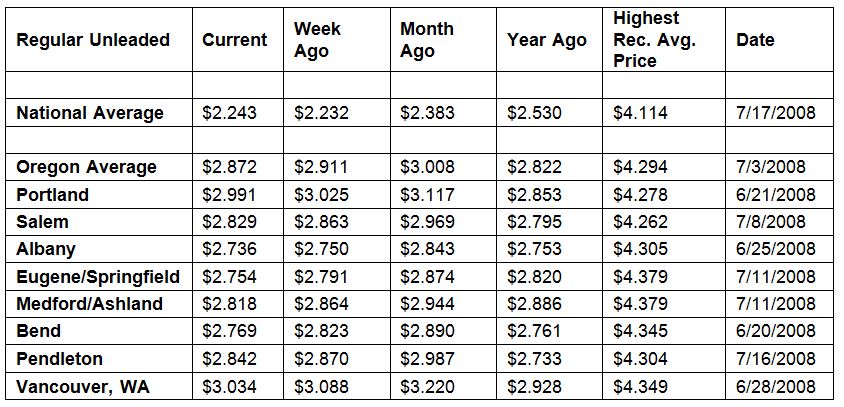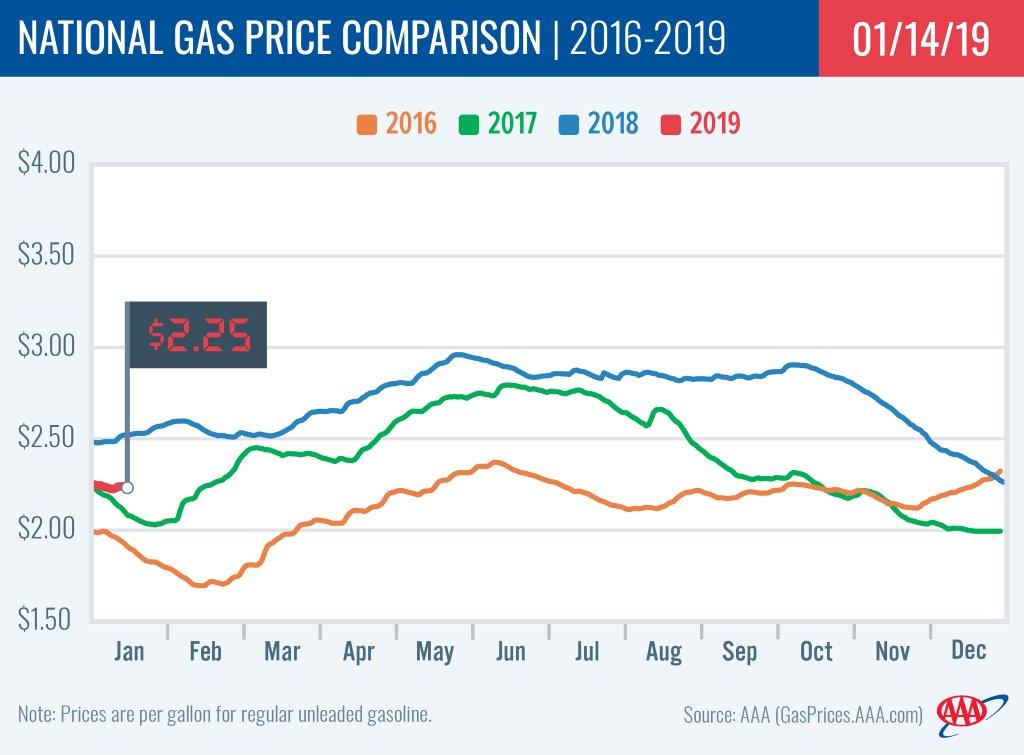PORTLAND, Ore., – The national average for regular is creeping up for the first time since October while the Oregon average continues to decline. For the week, the national average adds a penny to $2.24 a gallon while the Oregon average slides four cents to $2.87.
“Crude oil prices have been slowly and steadily increasing and that’s putting some upward pressure on retail gas prices nationwide,” says Marie Dodds, public affairs director for AAA Oregon/Idaho. Last week also saw a sizeable build in U.S. gasoline stocks and a small increase in demand. Overall demand has been low for the past several weeks, contributing to the growth in stocks and helping to keep gas prices relatively low despite increasing crude oil prices.
Oregon is one of 24 states where gas prices are lower week-over-week. Wyoming (-8 cents) has the largest drop. Ohio has the largest weekly increase (+8 cents). This week two states have averages at or above $3 a gallon, down from four a week ago.
All 50 states and the District of Columbia have lower prices now than a month ago. The national average is 14 cents less and the Oregon average is also 14 cents less than a month ago. Montana (-32 cents) has the largest monthly decrease. Delaware (-4 cents) has the smallest monthly decrease.
The West Coast continues to have the most expensive gas prices in the nation. California is most expensive for the second week in a row with Hawaii, Washington, Alaska, Nevada, Oregon and Arizona rounding out the top seven. Oregon is sixth most expensive for the second week in a row. While expensive, prices are falling in all West Coast states with Alaska (-6 cents) and Washington (-5 cents) having the region’s largest weekly declines.
| Rank | Region | Price on 1/15/19 | |
| 1 | California | $3.27 | |
| 2 | Hawaii | $3.27 | |
| 3 | Washington | $2.99 | |
| 4 | Alaska | $2.94 | |
| 5 | Nevada | $2.90 | |
| 6 | Oregon | $2.87 | |
| 7 | Arizona | $2.58 | |
| 8 | District of Columbia | $2.57 | |
| 9 | New York | $2.55 | |
| 10 | Connecticut | $2.54 |
The U.S. Energy Information Administration’s (EIA) weekly report shows that West Coast gasoline stocks surged by approximately 2.4 million bbl to 30.7 million bbl during the week ending on January 4, the largest one-week build in nearly 26 years. However, stocks are approximately 2.7 million bbl lower than at this time last year, which could cause prices to spike if there is a supply challenge in the region this week.
The nation’s cheapest markets are Missouri ($1.89) and Arkansas ($1.91). In all, 10 states have averages below $2 a gallon this week down from 12 states a week ago.
Oregon is one of seven states where drivers are paying more than a year ago to fill up. The national average is 29 cents less and the Oregon average is five cents more than a year ago. This is the fourth-largest yearly increase in the country. Arizona (+26 cents) has the greatest year-over-year increase; Nevada (+22 cents) is second; California (+10 cents) is third; and Washington (+5 cents) is fifth.
Oil Market Dynamics
Oil prices climbed above $51 per barrel last week. The increase was largely due to optimism that the trade tensions between China and the U.S. may be easing. Reduced trade volatility will likely help curtail stalled global economic growth that could have reduced global demand for crude. In addition, with OPEC’s global pact with large non-OPEC crude producers (including Russia) to reduce crude production by 1.2 million b/d for at least the first six months of 2019 now in effect, the global glut of crude is expected to decline, helping to push crude prices higher. If crude prices continue to climb, pump prices will likely follow suit.
In related news, EIA reported that total domestic stocks of crude fell from 441.4 million bbl to 439.7 million bbl in its latest weekly petroleum status report. Additionally, Baker Hughes, Inc. reported that the U.S. lost four oilrigs last week, bringing the current total of active oilrigs to 873. When compared to the total number of active rigs at this time last year, there are 121 more rigs this year.
At the close of Friday’s formal trading session on the NYMEX, WTI decreased $1.00 to settle at $51.59. At the close of Monday’s formal trading session on the NYMEX, WTI lost $1.08 to settle at $50.51. Today crude is trading around $52, compared to $49 a week ago. Crude prices are up about five percent in the last month and are about $14 per barrel lower than a year ago.
Drivers can find current gas prices along their route with the free AAA Mobile app for iPhone, iPad and Android. The app can also be used to map a route, find discounts, book a hotel and access AAA roadside assistance. Learn more at AAA.com/mobile.
Diesel
For the week, the national average falls two cents to $2.93 a gallon. Oregon’s average drops four cents to $3.11. A year ago the national average for diesel was $2.93 and the Oregon average was $3.05.
Find current fuel prices at GasPrices.AAA.com.
AAA news releases, high resolution images, broadcast-quality video, fact sheets and podcasts are available on the AAA NewsRoom at NewsRoom.AAA.com.



